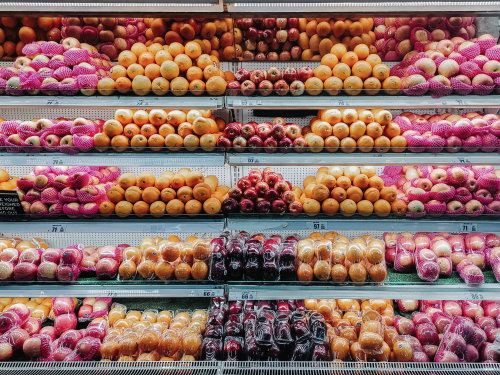I’m sure we don’t need to tell you that the cost of food—especially healthy food—has been rising, and fast. It also doesn’t take long to realize that some of the unhealthiest options are way cheaper than those that are better for you. I mean, why can you get a fast-food burger, fries, and a soft drink for less than half the cost of most healthy whole-food meals? No wonder so many people are suffering from both obesity and malnutrition at the same time. That’s why it’s important to get better at grocery shopping on a budget—especially a tight one.
BREAKING: 1 Cup of This Melts Belly and Arm Fat (Take Before Bed)
Fortunately, eating healthfully doesn’t have to be a luxury. In fact, with the tips below, you’ll quickly become a pro at creating your healthy grocery list on a budget and still filling up your basket with delicious, healthy foods, affordably.
How Much Should You Spend on Groceries?
According to financial wizards, housing, groceries, and other essentials should make up no more than 50% of your income. On average, in the U.S. (in 2021), a household spends about $412 per month. And according to the USDA, a family of 4 “should” spend somewhere between $682 and $1,361 per month.
Of course, that number will go up or down depending on:
- Where you shop
- What you buy
- How much you buy
- How many people you’re feeding
- How often you eat away from home (i.e., foods you don’t cook, such as restaurant and school meals or meals prepared by friends and family)
- Where you live
- If you grow any of your own food
The USDA (Department of Agriculture) has put together monthly food plans to help start the conversation for healthy meals and snacks that can be made at home. There’s a Thrifty Plan, a Low-Cost Plan, a Moderate-Cost Plan, and a Liberal Food Plan, all of which are updated monthly and further broken down depending on age and gender.
Of course, these just provide estimates for what similar people may be spending. Your grocery budget may differ quite a bit, and by following the tips below, you may even be able to get below those standard costs. Some savvy shoppers are even able to cut their costs in half. Isn’t budgeting fun?
Tips to Create a Healthy Grocery List on a Budget
There are few better feelings than trimming your grocery costs and waistline at the same time. No, we don’t just mean by cutting down on the calories you buy (though that helps) or having marathon coupon-cutting sessions (which can also help). In fact, it may be easier than you think to create a healthy grocery list on a budget. So, let’s get started…
Tip 1: Meal Plan
You’ve probably heard the saying, “If you fail to plan, you plan to fail.” And it’s no different with grocery shopping. Planning your meals can save you time and money. You can further save by having planned leftovers (for lunch or dinner another night) or using the same ingredients in more than one recipe. You can also avoid throwing out foods by planning to eat the most perishable ingredients (such as berries and tender greens) at the beginning of the week.
Once you know what you’re making, it’s time to make a list. Then when you’re at the store, buy only what’s on the list. If you have kids, a partner, or even a roommate who’s a little more impulsive and will lobby for foods that aren’t on the list, leave them at home or do your shopping when they’re at school or work to help you stick to your healthy grocery list.
What if you’re the impulsive one? Only shop with a full belly, so you’ll be less swayed by temptation, or take advantage of ordering online and picking up with curbside delivery. You’ll know exactly what you’re buying and spending without ever stepping foot inside and risking that temptation.
Advanced Tips: Grab a calendar and meal plan for an entire month so you can do one large bulk shop per month when you purchase pantry and freezer items at discounted prices (as long as you have room in your pantry and freezer). You can often save the most by buying meat in bulk and storing it in a freezer for several months or up to a year.
Try shopping at large warehouse-type stores (such as Costco or Sam’s) for items like chicken broth, noodles, meats and fish to divide and freeze, peanut butter (or PB powder), oatmeal, rice, beans, nuts, and more. Or, if you are a meat eater and have a large freezer, go in with friends or family members and purchase a whole animal from a local rancher, which can save hundreds of dollars over the year.
Remember to store grains and nuts in airtight containers, which allows them to last for several months without losing nutrients or flavor.
Tip 2: Build Your Meals Around Affordable Foods
While we all enjoy indulging from time to time, you can greatly save on your healthy grocery list by making delicious meals that start with the most affordable foods. These include:
- Eggs
- Less expensive cuts of meat (e.g., chicken thighs, whole turkey, stew meat, pork)
- Peanut butter
- Edamame
- Canned tuna, salmon, or sardines
- Protein powder
- Plain Greek yogurt
- Cottage cheese
- Milk
- Pumpkin seeds
- Sunflower seeds
- Popcorn (to air pop at home)
- Beans (dried or canned)
- Lentils
- Potatoes
- Sweet potatoes
- Carrots
- Cabbage
- Bananas
- Oats
- Quinoa
- Amaranth
- Brown rice
- Pasta
- Pasta sauce
- In-season fresh produce
- Frozen or canned vegetables
Tip 3: Shop Around
Some stores sell the same food items for less than others, so it’s worth shopping around. For instance, you can often find great deals on non-perishable foods from online retailers like Amazon, Vitacost, and Costco. Don’t, however, assume that the price is lower just because you’re shopping at a wholesale or warehouse store. Check prices between stores, and learn which one has the biggest discounts on your favorite foods.
And don’t neglect local options in your area. Farmers’ markets, bakeries, butchers, and other food producers may offer the best deals, especially for perishable foods made the day before. Plus, you’ll be supporting a local small business.
Advanced Tip: While it makes sense to buy some foods in bulk, others can go to waste (and waist). If you have a small family and need just a few grape tomatoes for your recipe, for example, skip on the larger package, even though it costs less per ounce. You may save a buck or two on the total grocery cost and come home with just the right amount.
Advanced Tip: Hit the farmers’ market near the end of the day. Sure, your options may be a bit more limited, but you may be able to find better deals on any unsold products.
Tip 4: Compare Prices
If you read the tip above and thought, “who’s got time for that?!” take out the legwork by doing at least some of your research online. Grocery stores provide coupons and sales prices on their websites and apps, so you can compare costs from the comfort of your own couch (or table, desk, or wherever you do your research).
Advanced Tip: Rotate through your local grocery stores weekly to take advantage of the discounts and deals from each store. If it’s less expensive at another store, then hold off on purchasing it until you hit that store the next week.
Tip 5: Shop Your Pantry, Fridge, and Freezer First
Before even heading to the store, double-check your pantry to see what you have and design your meals around what’s available. The average American household tosses up to $1,600 of produce each year. Wow! That’s a lot of grocery money—before even considering expired items and leftovers.
If you do run across a good sale, it can be tempting to stock up—but you’ll save even more if you just use what you already have. It can be hard to remember what you have previously bought, though. One simple solution is to take a quick photo of your fridge and pantry, so you have a reminder while you’re at the store to prevent you from doubling up on your purchases.
Advanced Tip: Not sure what to do with those fading veggies or herbs? Create a pot of soup or vegetable broth to use in other recipes. They’ll still provide a lot of flavor and nutrition even if they don’t look their best. (Of course, you’ll still want to compost any that look moldy or completely dead.) You might be surprised to find you have a full meal or two you can whip up with just the leftover ingredients you already have! If you are still developing your “chef’s skills,” search for the foods you have on hand followed by the word recipe to find possible options or at least a starting point (e.g., “leeks, garbanzo beans, artichokes recipe” or “salmon, tomato, spinach recipe”).
Tip 6: Buy In-Season
A healthy diet is one that’s loaded with nutrient-rich whole foods like veggies and fruits. However, those costs can go way up, especially when they’re out of season and need to be shipped long distances from greenhouses far away. Even some meats can be more affordable depending on the season.
Advanced Tip: Know what’s in season, so you can get the best deals in the fall, winter, spring, and summer, such as:
Fall:
- Apples
- Beets
- Broccoli
- Brussels sprouts
- Butternut squash
- Cranberries
- Spinach
- Sweet potatoes
- Swiss chard
- Tangerines
- Turnips
- Winter squash
Winter:
- Artichokes
- Cabbage
- Cauliflower
- Celery
- Grapefruits
- Lemons
- Oranges
- Pears
- Radishes
- Turnips
Spring
- Apricots
- Asparagus
- Cherries
- Leeks
- Lettuce
- Mushrooms
- Okra
- Pineapples
- Radishes
- Rutabagas
- Spring peas
- Strawberries
- Swiss chard
- Zucchini
Summer
- Blackberries
- Blueberries
- Butternut squash
- Cantaloupe
- Corn
- Cucumbers
- Kiwi
- Eggplant
- Figs
- Green beans
- Mangos
- Peaches
- Peppers
- Plums
- Summer squash
- Tomatoes
- Watermelon
Tip 7: Don’t Overlook Canned and Frozen
In season, you may be able to get the best deals on perishable fruits and vegetables in the produce section. The rest of the year, the best deals are more likely to be found in the frozen and even canned foods sections. These tasty foods are often just as nutritious as fresh (or even better since they’re picked at peak freshness). Plus, there’s no worry that they’ll go bad before you have a chance to eat them.
You can also use your freezer to save foods from going bad. For example, if you buy a batch of strawberries but can’t eat them within a couple of days, you can rinse them off and place them in one layer on a cookie sheet and freeze. Once fully frozen, you can move them off the sheet and into freezer-safe bags or containers to enjoy another day.
Advanced Tip: Take advantage of end-of-season sales (or even harvests from your garden)—especially end-of-day opportunities at the farmers’ market—by buying up produce you can freeze, pickle, or can yourself. Some good options include berries, bananas (peeled and cut into chunks), pineapple, corn, peas, broccoli, cauliflower, carrots, green beans, squash, cold weather greens (like spinach, kale, chard, and collard greens), onions, peppers, and herbs.
Tip 8: Avoid Pre-Packaged Meals
While sometimes you need to save time by getting help where you can get it, such as by purchasing premade rotisserie chicken, cut-up vegetables, or even premade salad dressings, those conveniences can come at a steep price to your wallet as well as (at times) your waistline. Yes, they can help you get dinner on the table faster, but they’re often much more expensive than making the food from scratch. Plus, many of these types of foods also come with added refined fats, unnecessary chemicals, and other additives. (That said, they’re usually much cheaper and lower calorie than going out, so take advantage when need be.)
The same goes for pre-portioned snacks. Yes, it’s helpful to have foods packaged individually to grab and go quickly or help you avoid overeating, but those foods are usually much more expensive. Instead, buy them in bulk and then portion them yourself in reusable bags or food containers when you get home.
Advanced Tip: To make dinner easier, preplan and prep meals, so they’re ready to eat. Chopped vegetables like onions and peppers can last up to two weeks when stored correctly in the fridge. And if you freeze them, they can last even longer. Instead of purchasing a precooked (or even pre-marinated) cut of meat or chicken, you can prepare the meat in advance in your own crockpot or air fryer at a more affordable price.
Tip 9: Follow the Deals
TRENDING: This Keeps Your Blood Sugar Below 100 - Even When You're Eating Sweets!
Coupons, coupons, coupons. Yes, they can cut costs significantly—if you use them correctly. That is, just because you have a coupon doesn’t mean you have to use it. If it isn’t a product you use, that’s healthy, or it’s a product that’s overpriced to begin with, then don’t bother. That said, if you find a coupon for a product you regularly buy, use it. Those cents can add up to dollars quickly.
Just remember that coupons are marketing tools. Don’t get caught up on “saving money” on products you typically don’t buy or that aren’t in line with your healthy eating plan. This can cause you to overspend and have foods in your home you don’t really want to eat, such as calorie-laden (and costly) ultra-processed, convenience foods.
You might also find that the generic option is still cheaper than the brand name, even with a coupon. But remember, most generics are the same quality as the more premium brand names and are often even produced in the same factory with the same ingredients.
Finally, at the very least, if you shop at a store regularly, go ahead and sign up for their rewards card or app to take advantage of in-store coupons.
Advanced Tip: If the product isn’t perishable (or can be frozen), stock up when it’s on sale or you have a coupon. And take advantage of opportunities to stack store coupons on top of manufacturer coupons and rebates.
Tip 10: Avoid Shopping
Of course, you need groceries, so you can’t avoid going to the grocery store forever. But if you find yourself stopping at the store every few days, chances are really good that you’re picking up more than you popped in to get. All those extra shopping trips can lead to a lot of temptation that leads to overspending and, potentially, a lot of excess calories.
Pick up everything you need in one weekly trip, and keep a running list of any foods you’re low on either on your fridge, on a whiteboard, or on your phone, so you can take the list with you instead of forgetting you were almost out of, say olive oil, oatmeal, or honey. You may even be able to set up your smart speaker to add to your list as you run out.
Advanced Tip: Do most of your shopping once a month, perhaps at a discount store, and pick up staple items you can use in multiple meals. Then only pick up highly perishable foods like fresh produce, dairy, and eggs in your weekly grocery store runs.
Tip 11: Go Meatless
Even if you aren’t a vegetarian, leaving meat off the menu for a few meals a week can be a great way to create a healthy grocery list on a budget. Meat, after all, is often one of the most expensive ingredients, even if you’re only buying the cheapest cuts. And there are plenty of meals that are just as delicious, nutritious, and even high in protein, such as these favorites:
- Thai Curry
- Tex Mex Cauliflower
- Zucchini Recipes
- Vegan Protein Pancakes
- Vegan Protein Snacks
Even with rising costs at the grocery store, it’s possible to cut overall costs to eat a healthy, nutrient-dense diet that’s still affordable. Hey, you may even become one of those savvy shoppers who can cut their grocery bill in half. See, budgeting really can be fun.









